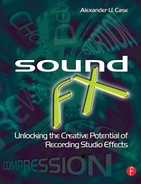Section 1: Sound — Signals, Systems, and Sensation
1.8.1 Mistaking the Message for the Medium
1.8.2 Don′t Picture These Sketches
2.3.1 Parallel and Serial Processing
4.1.2 Intermodulation Distortion
5.2Parameters for Spectral Modification
Chapter 6: Compression and Limiting
6.3Nominal Application: Dynamic Range Reduction
6.3.3 Increase Perceived Loudness
6.3.4 Improve Intelligibility and Articulation
6.4.1 Altering Amplitude Envelope
6.5Advanced Studies — Attack and Release
6.5.2 Visualizing Attack and Release
6.5.3 Parameter Interdependence
6.6Learning Compression — Some Personal Advice
6.6.1 Unnaturally Difficult to Hear
6.7Achieving Compression Success
Chapter 7: Expansion and Gating
7.3.3 Gating Through Waveform Editing
9.4.1 Constructive and Destructive Interference
11.2The Need for Reverb Devices
11.2.3 Creative Microphone Technique
11.3.2 Acoustic Reverberation Chambers
11.4.2 Non-Spatial Applications
Chapter 12: Basic Mix Approach
15.2.1 Faders and Cuts Automation
15.3.2 Write: Absolute or Relative
15.4Automation Strategies: Organizing the Infinite Options
15.4.2 Phase II: Signal Processing
15.4.5 Phase V: Tweaks and Special Effects
